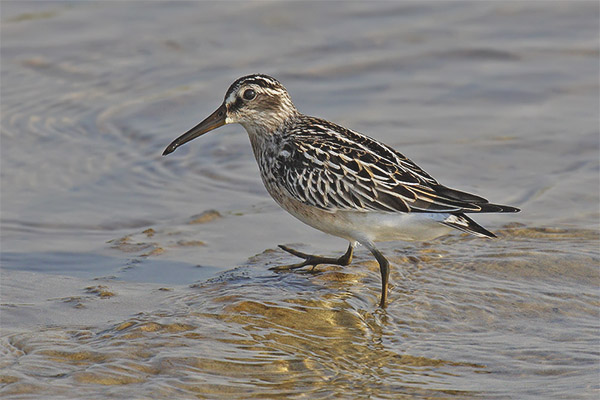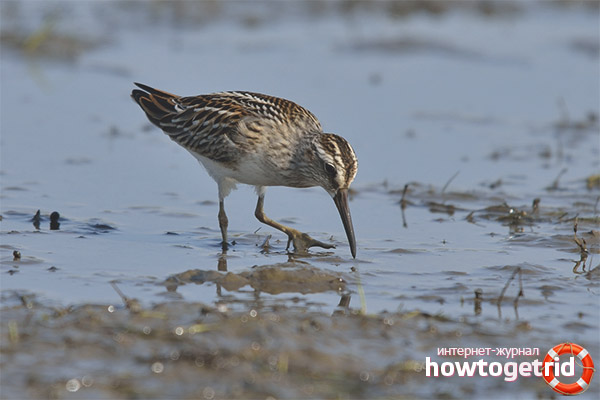The content of the article
In Latin, the species of bird burley is called Limicola falcinellus.
Description
In size, these birds are slightly smaller than the starling. Their body is about 15 cm in length, with a wingspan of about 31 cm. Representatives of this species are typical sandpits in terms of their constitution. But they differ from the others in that there are stripes on the crown. The bill is quite long and massive. And its top is slightly flattened and bent downwards.
In spring and summer, adult individuals appear dark at the top. From below, they look white. This type of bird has because the wings from the outside in the middle are painted in a brownish color. On the edge, they have a bright border. The throat, front part of the neck, part of the sides are covered with dark-colored spots and mottled. Over time, the hem on the wings becomes darker as it wears off.
It is very difficult to distinguish a male from a female. The color of the representatives of different sexes is the same.The only difference is that the females are slightly larger. The legs of these birds may be yellow, brown or gray. The beak is black, has a slightly olive tint. His base is brown. In young individuals at the beginning of autumn the color is somewhat paler. The light areas in the plumage are still fresh and not worn. On the neck, as well as on the sides there are mottles, but they are blurred. In the fall, some individuals begin to form a winter outfit, but completely the molt ends only in winter.
In its winter plumage, the bristle is painted gray on top, and white on the bottom. White eyebrow remains. Nestlings who have not had time to cover themselves with a feather are dark brown in the upper part. The body is covered with large black spots and white patches. Bottom plumage has a dirty white color.
In Europe, you can see only birds belonging to the nominative subspecies.
Spread
You can see the bird in the southern regions of the tundra and in the north of the taiga. It usually settles in swamps.During flights, it makes stops on meadows and sea coasts.
Behavior
Gruzovik usually leads a secretive lifestyle. During the flight, it extracts food for itself alone. Sometimes it can form a flock together with other members of the family. In the habitat is very difficult to see. They walk along shallow water in rivers, lakes or bays, looking for food in the mud with their beak.
The time is spent by the dowser, mainly in the thickets of plants growing near the marshes, on a muddy beach.
Often combined in flocks with related species.
In the nesting period, the hunter is very secretive. He hides in the swamps in the thickets of sedge. You can see the bird during the token. The bird feeds food by probing the soil or collecting it in the water. When a rag looking for food, it moves slowly. Runs from place to place only occasionally.
Breeding
In places of nesting these birds usually live in colonies. In each of them about 20 pairs of birds. They prefer to build nests on a dry piece of swamp. They choose a place in a high grass, and also in dense bushes. The nest is lined with birch and willow leaves.
Eggs are laid closer to July. In one clutch there are usually about 4 of them.They are light brown in color with reddish specks. Hatching parents are engaged in turn. After 3 weeks, chicks appear.
The number of this species in nature is not precisely defined. According to some data, about 2000 individuals live in Finland. On the territory of the Murmansk region there are several hundred individuals.
If the bird notices the danger near the nest, it starts to make distracting movements and squeak. It feeds on insects, worms. Sometimes eats crustaceans and mollusks. Can eat the seeds of some algae and plants growing near the water.
Migrations
Security
Gryazovik bird is protected by law since 1984. Refers to a rare species. In some regions of Russia are listed in the red book.
Vote
The sound of a bogger is quite characteristic.Sometimes his cry is like the sounds of a Dunlin. But the ragman makes a more buzzing sound. Most often you can hear the "chrry." The trills consist of jyr sound replays.












To send